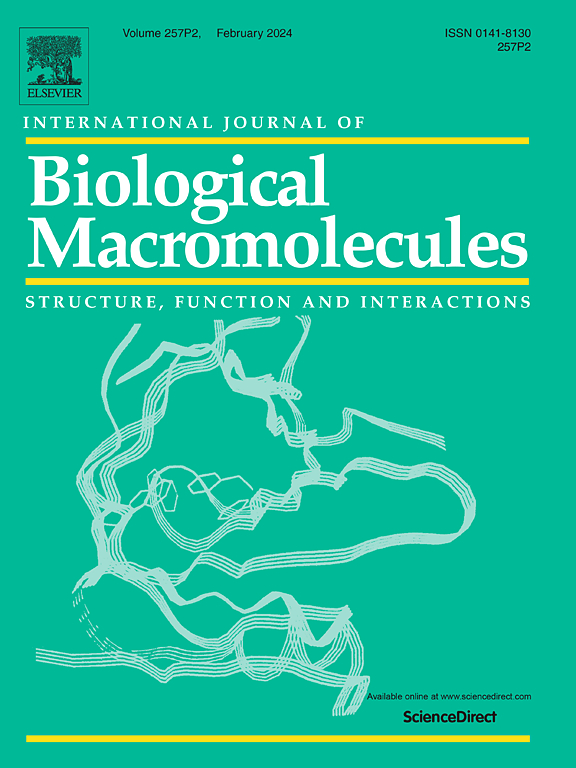制作具有潜在生物应用价值的黄胶和壳聚糖低温凝胶聚电解质复合物。
IF 8.5
1区 化学
Q1 BIOCHEMISTRY & MOLECULAR BIOLOGY
International Journal of Biological Macromolecules
Pub Date : 2024-12-01
DOI:10.1016/j.ijbiomac.2024.137916
引用次数: 0
摘要
为了更深入地了解黄原胶(TG)和壳聚糖(CS)的生物相容性聚电解质复合物(PEC)在生物领域的潜在应用,我们制备了黄原胶和壳聚糖的 PEC 冷凝胶。研究了不同的 TG:CS 比例,以优化 PEC 特性。根据共凝产率、吸水率、上清液粘度、浊度和流变特性,选择 18:2 作为 TG:CS 的最佳比例。选择 pH = 4 作为优化点,使阴离子多糖和阳离子多糖之间的相互作用达到最高水平。PECs 的 zeta 电位表明了多阴离子和多阳离子之间的电荷中和,傅立叶变换红外光谱也对其进行了研究。低温凝胶呈现出叶状的大孔板结构和分布在 2.4 纳米和 4.6 纳米之间的狭窄中孔。PECs 具有抗菌活性,在 1 小时内减少了 95% 的大肠杆菌,24 小时后减少了 99.9%;在 1 小时内减少了 80% 的金黄色葡萄球菌,24 小时后减少了 99.9%。TG:CS 低温凝胶粘附在人成纤维细胞系(HFFF2)上,不会产生细胞毒性。划痕试验验证了该冷凝胶可在 48 小时内有效诱导人成纤维细胞的伤口闭合。本文章由计算机程序翻译,如有差异,请以英文原文为准。

Fabrication of cryogel polyelectrolyte complex of Tragacanth gum and chitosan with potential biological applications
To provide more insight into the potential applications of the biocompatible polyelectrolyte complexes (PECs) of Tragacanth gum (TG) and chitosan (CS) in the biological fields, the PEC cryogel of TG and CS were fabricated. Different TG:CS ratios were examined to optimize the PEC characteristics. Based on coacervation yield, water absorption, supernatant viscosity, turbidity, and rheological properties, 18:2 was chosen as the optimized ratio of TG:CS. The pH = 4 was selected as the optimized point, resulting in the highest level of interactions between anionic and cationic polysaccharides. The zeta potential of PECs was indicative of the charge neutralization between polyanions and polycations which were also studied by FTIR spectra. The cryogel exhibited a macroporous plate structure in leaf-like form and narrowed mesopores distributed around 2.4 and 4.6 nm. PECs exhibited anti-bacterial activities, reducing 95 % of E. coli within 1 h and 99.9 % after 24 h, as well as 80 % of S. aureus after 1 h and 99.9 % after 24 h. TG:CS cryogel adhered to the human fibroblast cell lines (HFFF2) without cytotoxicity effects. The scratch assay validated that the cryogel effectively induced wound closure in human fibroblast cells within 48 h.
求助全文
通过发布文献求助,成功后即可免费获取论文全文。
去求助
来源期刊
CiteScore
13.70
自引率
9.80%
发文量
2728
审稿时长
64 days
期刊介绍:
The International Journal of Biological Macromolecules is a well-established international journal dedicated to research on the chemical and biological aspects of natural macromolecules. Focusing on proteins, macromolecular carbohydrates, glycoproteins, proteoglycans, lignins, biological poly-acids, and nucleic acids, the journal presents the latest findings in molecular structure, properties, biological activities, interactions, modifications, and functional properties. Papers must offer new and novel insights, encompassing related model systems, structural conformational studies, theoretical developments, and analytical techniques. Each paper is required to primarily focus on at least one named biological macromolecule, reflected in the title, abstract, and text.

 求助内容:
求助内容: 应助结果提醒方式:
应助结果提醒方式:


